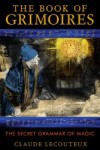Review : The Book of Grimoires July 21, 2014
Author: Beach Combing | in : Medieval, Modern , trackbackClaude Lecouteux is one of the world’s most interesting writers on folklore and magic: his work on the wild hunt, for example, is perhaps the best we have. However, this new book by CL, The Book of Grimoires: The Secret Grammar of Magic (2013 Inner Traditions, from the French original, 2002) is not strictly by Claude Lecouteux at all. Yes, there is a nice introduction and some rather pious don’t-do-this-at-home-and-don’t-blame-me-if-you-do remarks. But CL contribution to this volume has been to gut a half dozen medieval magic volumes and then, very roughly, classify the spells with an intelligent apparatus. In other words this is a reader….
Now most readers are just not that interesting even, sigh, ones that should be. But magic from the western tradition makes for a curiously het-up couple of hours browsing. In fact, the closest experience this blogger has come to reading two hundred magic spells is to flicking through a poetry miscellany. Some of the spells are lyrical, some are gross, some are resonant, some make you think: but all taste powerfully on the mental palate. Samples (paraphrased):
Improve your memory: bury pumpkin seeds in a man’s skull smeared with human brain. Let the seeds germinate and grow there. Eat the pumpkins.
It could almost be a haiku. Now for the sonnet.
Make an invisible sword: buy a blade in the hour of Mars. Guard forged on Tuesday, the day of Mars. Get some wood struck by lightning and shape it for the hilt. Attach a spoke from a wheel on which a man has been killed and attach a snakeskin with eel hide to your right arm. A sliver from an executioner’s sword made, with gold and silver, into a ring with a seal. When you fight go into battle with imprint of the seal on your forehead.
Win at cards: Attach bat heart to a red thread to the arm that deals cards.
Fear of leprosy: ingest the powdered foreskin of a burnt man pulverised and eaten with incense and mastic, cinnamon and clove.
Know something hidden: put a recently decapitated head with fresh poppy, human blood and sesame oil and seal in a pot over a ‘gentle charcoal fire’ (love that bit). Filter and use the oil for a lamp, to smear on something to to feed to someone.
Even the titles are intoxicating. Two of my favourites: ‘To make a woman lift her skirts’ while passing through the door, and the winningly general a ‘charm for everything’.
From here we come to the most troubling questions of all. Why did this stuff work? Obviously desperate people are prepared to do anything: in a very bad moment Beach once went to a herbalist… if you have a child ill in bed or if you really want to see Lady Kate lift her skirt as she passes past the gateway, then, of course, you will pay through your nose to get a sorceror.
But there has also to be the suspicion that ritualised magic really did something: particularly if you take suggestibility and placebo seriously. After all, we have an authority figure making the medieval equivalent of sugar pills. ‘Go and get me that skull…’, ‘now I will bleed you’, ‘now where are those pumpkin seeds’, ‘yes eat them, can you taste the power of thought?!’ etc etc.
We should have the good sense to allow that a witch chanting to a small-pox sufferer ‘So is it true that he went into hell? So is it true that he broke the doors of hell? So is it true that he bound the evil one? So is it true that the saints led…’ would be listened to in awe.
Sometimes though the spells are closer to Monty Python. Pity, for example, the epileptic sufferer who has ‘Ananizapta’ whispered in his right ear while the wizard flexes his knees up and down. I would have laughed before passing out again…
Other explanation for why this stuff works (if indeed it does): drbeachcombing AT yahoo DOT com
24 July 2014 Nathaniel writes: When evaluating if/why grimoires “work”, maybe we should ask “compared to what?”. If the comparison is to the standard medical procedures of their times, the grimoires could hardly be worse even if they did some harm, or nothing. John Keegan in “The Face of Battle” describes the “treatment” of a British army officer wounded at Waterloo. After a surgeon cut the bullet out, the patient was bled of a quart of blood, then put on a horse and taken to Brussels. After that he was bled several times a day for three weeks until he refused further “treatment”. His wound finally burst open and discharged a lot of pus, after which he began to recover. Medicine like that set a pretty low bar for magic to beat.’ Thanks, Nathaniel!



